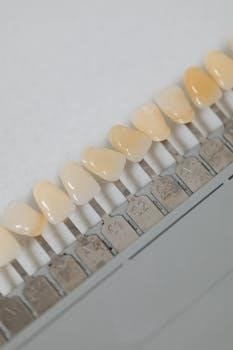Guided Implant Surgery⁚ An Overview
Guided implant surgery represents a modern advancement in dental implantology. It utilizes precise surgical guides, often created with computer-aided design and manufacturing (CAD/CAM) technology, to enhance the accuracy and predictability of implant placement. This approach minimizes risks and optimizes surgical outcomes for patients needing dental implants.
What is Guided Implant Surgery?
Guided implant surgery is a sophisticated technique in modern dentistry that leverages advanced imaging and computer-aided technology to precisely place dental implants. Unlike traditional methods that rely primarily on the surgeon’s experience and visual assessment during surgery, guided surgery incorporates detailed pre-operative planning. This involves using cone-beam computed tomography (CBCT) scans to create a three-dimensional model of the patient’s jawbone and surrounding anatomical structures.
Based on this model, a surgical guide is designed and fabricated, often using CAD/CAM technology. This guide is a custom-made template that fits over the patient’s teeth or gums and indicates the exact location, angle, and depth for implant placement. The surgical guide minimizes the need for constant checks and adjustments, reducing the risk of complications during the procedure.
The use of guided surgery enhances accuracy, reduces surgical time, and improves patient comfort by minimizing tissue damage. It also allows for better prosthetic outcomes, ensuring the final restoration fits perfectly and functions optimally. Ultimately, guided implant surgery aims to provide a safer, more predictable, and more efficient implant placement experience for both the surgeon and the patient.

Benefits of Guided Implant Surgery
Guided implant surgery offers numerous advantages over traditional methods. These include enhanced accuracy, reduced risks, minimized discomfort, shorter surgical time, and improved prosthetic outcomes. The precision afforded by guided surgery leads to more predictable results and greater patient satisfaction.
Enhanced Accuracy and Precision
One of the primary benefits of guided implant surgery lies in its enhanced accuracy and precision. Utilizing advanced imaging techniques, such as cone-beam computed tomography (CBCT), clinicians can meticulously plan the ideal implant placement before the actual surgical procedure. This pre-surgical planning is transferred to the mouth through a custom-made surgical guide, ensuring that the implant is positioned precisely according to the treatment plan.
This level of accuracy minimizes the potential for errors during surgery, reducing the risk of damaging adjacent teeth or vital anatomical structures, such as nerves and sinuses. The precise placement also contributes to better osseointegration, the process by which the implant fuses with the surrounding bone, leading to a more stable and long-lasting restoration.
Furthermore, enhanced precision simplifies the restorative phase of treatment, allowing for more predictable and aesthetically pleasing results. The improved accuracy in implant placement translates directly into more accurate and well-fitting crowns, bridges, or dentures, ultimately enhancing the patient’s overall satisfaction with the outcome. Guided surgery ensures optimal alignment and angulation.
Reduced Risks and Complications
Guided implant surgery significantly reduces the risks and complications often associated with traditional implant placement methods. The meticulous pre-operative planning, facilitated by advanced imaging and surgical guides, allows clinicians to visualize vital anatomical structures and avoid potential damage during the procedure. This is especially crucial in areas with limited bone volume or proximity to nerves and sinuses.
By precisely guiding the implant placement, the risk of nerve injury, sinus perforation, and damage to adjacent teeth is substantially minimized. The surgical guide acts as a physical barrier, preventing the surgeon from deviating from the pre-planned trajectory and depth. This controlled approach reduces the likelihood of complications such as bleeding, swelling, and post-operative pain.
Moreover, guided surgery can minimize the need for extensive bone grafting procedures, as it enables the surgeon to strategically position the implant in areas with sufficient bone support. This reduces surgical time, patient discomfort, and the overall cost of treatment. The reduced risk of complications also contributes to a higher success rate and improved long-term stability of the implant. The planning stage allows clear visualization of these structures.
Minimized Discomfort and Shorter Surgical Time
Guided implant surgery translates to a more comfortable experience for the patient, coupled with a reduction in overall surgical time. The precision afforded by the surgical guide often allows for a less invasive approach, potentially eliminating the need for extensive tissue manipulation and large incisions. This minimally invasive nature contributes directly to reduced post-operative discomfort, swelling, and bruising.
Furthermore, the streamlined workflow inherent in guided surgery contributes to a shorter chair time. With the implant placement meticulously planned and the surgical guide providing precise direction, the actual surgical procedure becomes more efficient and predictable. This minimizes the duration of the surgery, reducing patient anxiety and exposure to anesthesia.
The reduced surgical time also translates to faster healing and recovery periods. With less trauma to the surrounding tissues, patients can typically resume their normal activities sooner. In some cases, guided surgery may even allow for immediate loading of the implant, further shortening the overall treatment timeline and improving patient satisfaction. The use of guides minimizes the need for constant checks and adjustments.
Improved Prosthetic Outcomes
Guided implant surgery significantly contributes to improved prosthetic outcomes, enhancing both the function and aesthetics of the final restoration. By ensuring precise implant placement, guided surgery creates an ideal foundation for the prosthetic teeth. This meticulous placement allows for optimal support, stability, and long-term functionality of the implant-supported prosthesis.
The accurate positioning achieved through guided surgery facilitates the creation of well-fitting, natural-looking restorations. The restorative dentist can design and fabricate the prosthesis with greater confidence, knowing that the implant is ideally situated within the bone and in relation to the adjacent teeth. This precision allows for optimal emergence profiles, proper occlusal contacts, and harmonious integration with the patient’s natural dentition.
Furthermore, guided surgery can improve the longevity of the prosthetic restoration. By promoting even stress distribution on the implant and surrounding bone, it reduces the risk of overload and potential complications such as bone loss or implant failure. This contributes to the long-term success and stability of the entire implant-supported restoration. Better aesthetic results and improved prosthetic results are benefits.

Risks and Complications of Guided Implant Surgery
While guided implant surgery offers numerous advantages, it’s essential to acknowledge potential risks and complications. Although generally considered safe, like any surgical procedure, it carries inherent risks. Mechanical and technical risks in implant therapy should be considered. One potential complication involves nerve injury, particularly when placing implants near major nerve pathways. While guided surgery aids in visualizing these structures, careful planning and execution are crucial to minimize this risk.
Another possible complication is related to surgical guide fit and stability. Inaccurate guide fabrication or improper seating during surgery can compromise the precision of implant placement. It’s vital to verify the guide’s fit meticulously before proceeding with the surgical procedure.
Moreover, infection is a risk associated with any surgical intervention. Maintaining strict aseptic techniques and administering prophylactic antibiotics can help mitigate this risk. Seromas and hematomas of the implantation area are among the most common complications.
Additionally, unexpected anatomical variations or bone density issues can pose challenges during guided surgery. In such cases, the surgeon may need to adapt the planned approach or even revert to traditional implant placement techniques. Careful preoperative assessment and contingency planning are essential for addressing these potential challenges.

Surgical Guide⁚ The Key Component
The surgical guide stands as the cornerstone of guided implant surgery, playing a pivotal role in ensuring precise and predictable implant placement. This custom-fabricated template is designed using advanced imaging techniques, such as cone-beam computed tomography (CBCT), and sophisticated software to meticulously plan the ideal implant position. The guide acts as a physical intermediary, transferring the virtual plan from the computer to the patient’s mouth during surgery.
The surgical guide’s primary function is to direct the surgeon during osteotomy preparation and implant insertion, ensuring that the implant is placed at the pre-determined location, angulation, and depth. This precise control minimizes the risk of damaging adjacent anatomical structures, such as nerves, sinuses, and neighboring teeth.
The guide’s design incorporates features that provide stability and prevent movement during surgery, ensuring accuracy. It fits securely onto the patient’s teeth or bone, providing a stable platform for the surgeon to work from. Different types of surgical guides exist, including tooth-supported, bone-supported, and mucosa-supported guides, each suited to specific clinical scenarios.

Guided Implant Surgery vs. Traditional Implant Surgery⁚ A Comparison
Guided surgery offers increased precision and predictability compared to traditional methods. It minimizes risks, reduces surgical time and improves prosthetic outcomes; Traditional surgery relies more on the surgeon’s experience and anatomical landmarks, potentially leading to less accurate implant placement.
Implant Failure Rate
Studies suggest that guided implant surgery may correlate with a lower implant failure rate compared to traditional techniques. One study indicated an implant failure incidence of 2.25% for guided surgery versus 6.42% for non-guided approaches, implying a higher survival rate with guided methods. This reduction in failure can be attributed to enhanced accuracy, improved placement and minimized surgical trauma achieved through guided techniques. Precise planning and execution, facilitated by surgical guides, contribute to optimal osseointegration and long-term implant stability.
Accurate implant positioning, crucial for functional and aesthetic success, is more reliably achieved with guided surgery. This precision reduces the risk of complications such as nerve injury, cortical plate perforation, and improper prosthetic alignment, all of which can compromise implant stability and longevity. Furthermore, guided surgery allows for better visualization of anatomical structures during planning, minimizing the risk of damaging vital tissues and enhancing overall surgical predictability. The result is a potentially decreased risk of implant failure and improved long-term outcomes for patients undergoing dental implant procedures.
While guided surgery offers advantages, it’s important to acknowledge that implant failure can still occur due to factors unrelated to the surgical technique, such as patient health, bone quality, and post-operative care. However, the evidence suggests that guided implant surgery can contribute to a more favorable implant survival rate compared to traditional methods.